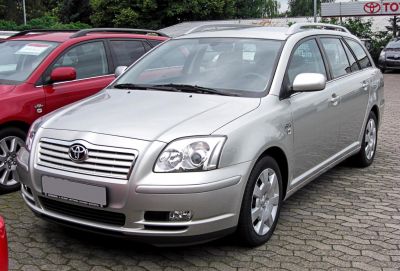 1998 Mazda 626 V Station Wagon (GF,GW) Dimensions, Size & Specs
1998 Mazda 626 V Station Wagon (GF,GW) Dimensions, Size & SpecsMeasurements of the 1998 Mazda 626 V Station Wagon, engineered for optimal performance and comfort
| Dimensions | |
|---|---|
| Length: | 4660-4670 mm183.5-183.9 in15.3-15.3 ft |
| Width: | 1710 mm67.3 in5.6 ft |
| Height: | 1515 mm59.6 in5.0 ft |
| Trunk Capacity: | 485-540 liter17.1-19.1 cu ft |
| Trunk Capacity (Max): | 1677 liter59.2 cu ft |
| Weight Specifications | |
| Curb Weight: | 1280-1385 kg2822-3053 lbs |
| Maximal permitted Weight: | 1840-1935 kg4057-4266 lbs |
| Tire Specifications | |
| Rims Sizes: | 15-inch rims:
|
| Tire Sizes: |
|
The Mazda 626 V Station Wagon, produced from 1998 to 2002 under the GF and GW generation codes, is a practical mid-size station wagon designed to offer both comfort and ample cargo space. Measuring between 4660 mm and 4670 mm in length (approximately 183.5 to 183.9 inches), with a width of 1710 mm (67.3 inches) and a height of 1515 mm (59.6 inches), the 626 V wagon provides a balanced footprint suitable for family use and everyday driving.
Weighing between 1280 kg and 1385 kg (2822 to 3054 lbs) when empty, and supporting a maximum gross weight ranging from 1840 kg to 1935 kg (4057 to 4266 lbs), this model strikes a fine balance between stability and efficiency. The wheel setup typically includes 6J x 15 rims paired with tires sized 185/65 R15 or 195/60 R15, ensuring good road grip and ride comfort.
One of the key highlights of the Mazda 626 V Station Wagon is its impressive luggage capacity. With all seats in use, the cargo space ranges from 485 liters to 540 liters (approximately 17.1 to 19.1 cubic feet), which is competitive within its class. Folding the rear seats flat boosts this capacity dramatically, expanding the luggage space to a generous 1677 liters (59.2 cubic feet), making it ideal for large loads, family trips, or bulky items.
Overall, the Mazda 626 V Station Wagon (GF, GW) is a reliable and versatile option in the station wagon segment from the late '90s and early 2000s. Its well-rounded dimensions, reasonable weight, and flexible cargo solutions make it a practical choice for buyers looking for a functional vehicle with the benefits of a spacious interior and manageable exterior size.
Discover the standout features that make the 1998 Mazda 626 V Station Wagon a leader in its class
Have a question? Please check our knowledgebase first.
The Mazda 626 V Station Wagon (GF, GW), produced between 1998 and 2002, has an exterior length ranging between 4660 mm and 4670 mm (183.5 to 183.9 inches), a width of 1710 mm (67.3 inches), and a height of 1515 mm (59.6 inches). These dimensions position the vehicle firmly in the midsize station wagon category, offering a balanced profile for both urban and highway driving while maintaining practical maneuverability.
The curb weight of the Mazda 626 V Station Wagon from 1998 to 2002 varies between 1280 kg and 1385 kg (2,822 to 3,053 pounds). This variation can be attributed to different engine options, trim levels, and additional equipment installed. The weight impacts fuel efficiency, handling, and performance, with lighter configurations typically offering better fuel economy and more nimble driving dynamics.
The maximum weight, or gross vehicle weight, of the Mazda 626 V Station Wagon (1998-2002) ranges from 1840 kg to 1935 kg (4,056 to 4,266 pounds). This represents the total weight the vehicle can safely carry, including passengers, cargo, and the car itself. Staying within this limit is crucial for maintaining safe driving conditions, optimal braking performance, and preserving the vehicle’s mechanical integrity.
The luggage capacity of the Mazda 626 V Station Wagon (GF, GW) ranges from 485 liters to 540 liters (17.1 to 19.1 cubic feet) with the rear seats in place. When the rear seats are folded down, the luggage capacity dramatically increases to 1,677 liters (59.2 cubic feet), providing ample space for transporting larger cargo or luggage. This versatility is a hallmark of the station wagon design, serving both family and utility needs.
Yes, the Mazda 626 V Station Wagon utilizes rims sized at 6J x 15 inches, paired with tire sizes 185/65 R15 or 195/60 R15. These specifications provide a balance between ride comfort, handling precision, and stability. The tire width and aspect ratio affect grip and responsiveness, while the 15-inch rim size supports good ride quality. These aspects are important for ensuring confidence and safety in various driving conditions.
The Mazda 626 V Station Wagon, with a length of approximately 4660-4670 mm (183.5-183.9 inches), a width of 1710 mm (67.3 inches), and height of 1515 mm (59.6 inches), comfortably fits into a standard residential garage. Typical garage dimensions (about 2.4 to 3 meters wide and over 5 meters deep) provide sufficient space for the vehicle with room to maneuver around it, making parking and storage convenient for most homeowners.
Compared to its predecessor, the Mazda 626 V Station Wagon (GF, GW) produced from 1998 to 2002 is generally larger and more spacious. While exact predecessor dimensions vary by specific model years, this generation extended its length to roughly 4660-4670 mm and improved interior space and luggage capacity significantly. This evolution represented Mazda’s focus on enhanced comfort, greater cargo versatility, and improved family usability compared to earlier station wagon models.
The Mazda 626 V Station Wagon competes well with other midsize station wagons from the late 1990s and early 2000s such as the Honda Accord Wagon and Toyota Camry Wagon. Its length of about 4660-4670 mm (183.5-183.9 inches), width of 1710 mm (67.3 inches), and large luggage capacity (up to 1677 liters or 59.2 cubic feet with seats folded) make it spacious and practical. While dimensions and capacities vary slightly among competitors, Mazda’s offering provided a good balance of passenger comfort, cargo space, and efficient use of interior volume.
The Mazda 626 V Station Wagon was well-regarded for blending practicality with driving comfort. Between 1998 and 2002, it featured a refined suspension setup for smooth rides, multiple engine options with efficient power output, and flexible cargo space with folding rear seats. Its styling embraced a modern and aerodynamic design while maintaining a family-friendly versatility. The car was also known for solid build quality and reliability, making it a popular choice for buyers seeking a dependable and capable midsize wagon.
Discover similar sized cars.

| Production: | 2003-2009 |
|---|---|
| Model Year: | 2003 |
| Length: | 4700-4715 mm185.0-185.6 in |
| Width: | 1760 mm69.3 in |
| Height: | 1525 mm60.0 in |

| Production: | 1998-2003 |
|---|---|
| Model Year: | 1998 |
| Length: | 4665 mm183.7 in |
| Width: | 1695 mm66.7 in |
| Height: | 1515 mm59.6 in |
